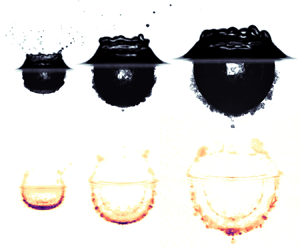Article contents
Rayleigh–Taylor instability in impact cratering experiments
Published online by Cambridge University Press: 28 February 2022
Abstract

When a liquid drop strikes a deep pool of a target liquid, an impact crater opens while the liquid of the drop decelerates and spreads on the surface of the crater. When the density of the drop is larger than the target liquid, we observe mushroom-shaped instabilities growing at the interface between the two liquids. We interpret this instability as a spherical Rayleigh–Taylor instability due to the deceleration of the interface, which exceeds the ambient gravity. We investigate experimentally the effect of the density contrast and the impact Froude number, which measures the importance of the impactor kinetic energy to gravitational energy, on the instability and the resulting mixing layer. Using backlighting and planar laser-induced fluorescence methods, we obtain the position of the air–liquid interface, an estimate of the instability wavelength, and the thickness of the mixing layer. We derive a model for the evolution of the crater radius from an energy conservation. We then show that the observed dynamics of the mixing layer results from a competition between the geometrical expansion of the crater, which tends to thin the layer, and entrainment related to the instability, which increases the layer thickness. The mixing caused by this instability has geophysical implications for the impacts that formed terrestrial planets. Extrapolating our scalings to planets, we estimate the mass of silicates that equilibrates with the metallic core of the impacting bodies.
JFM classification
- Type
- JFM Papers
- Information
- Copyright
- © The Author(s), 2022. Published by Cambridge University Press
References
REFERENCES
Lherm et al. supplementary movie 1
Liquid drop impact onto a deep liquid pool without density contrast, using a backlight illumination (ρ1/ρ2=1.0 and Fr=483).
Lherm et al. supplementary movie 2
Liquid drop impact onto a deep liquid pool without density contrast, using laser-induced fluorescence illumination (ρ1/ρ2=1.0 and Fr=481).
- 12
- Cited by





